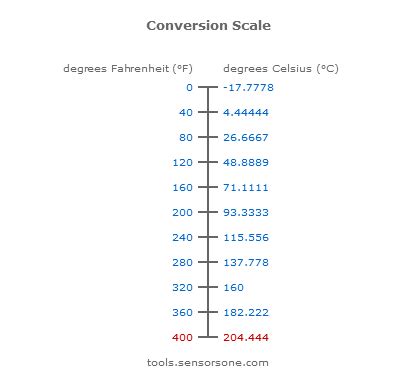400 Degrees Fahrenheit Is How Many Degrees Celsius
Kalali
Apr 03, 2025 · 4 min read

Table of Contents
400 Degrees Fahrenheit is How Many Degrees Celsius? A Comprehensive Guide to Temperature Conversions
Converting between Fahrenheit and Celsius is a common task, particularly for those working in fields requiring precise temperature measurements, such as cooking, engineering, or science. While many online converters exist, understanding the underlying formula empowers you to perform these conversions efficiently and accurately, anytime, anywhere. This comprehensive guide will not only answer the central question – what is 400°F in Celsius? – but also provide a deep dive into the conversion process, its applications, and relevant temperature-related information.
Understanding the Fahrenheit and Celsius Scales
Before delving into the conversion, let's briefly review the two temperature scales:
-
Fahrenheit (°F): This scale, developed by Daniel Gabriel Fahrenheit in the early 18th century, sets the freezing point of water at 32°F and the boiling point at 212°F, at standard atmospheric pressure.
-
Celsius (°C): Also known as the centigrade scale, Celsius, proposed by Anders Celsius, defines the freezing point of water at 0°C and the boiling point at 100°C, also at standard atmospheric pressure. This scale is more widely used globally for scientific and everyday purposes.
The Conversion Formula: Fahrenheit to Celsius
The fundamental formula for converting Fahrenheit to Celsius is:
°C = (°F - 32) × 5/9
This formula involves subtracting 32 from the Fahrenheit temperature, then multiplying the result by 5/9 (or 0.5556). Let's apply this to our primary question:
400 Degrees Fahrenheit in Celsius: The Calculation
To determine the Celsius equivalent of 400°F, we substitute 400 into the formula:
°C = (400 - 32) × 5/9
°C = 368 × 5/9
°C = 204.44°C (approximately)
Therefore, 400 degrees Fahrenheit is approximately 204.44 degrees Celsius.
Practical Applications of Temperature Conversions
Understanding Fahrenheit to Celsius conversion is crucial in various scenarios:
1. Cooking and Baking:
Recipes often specify temperatures in either Fahrenheit or Celsius. Accurate conversion ensures the desired cooking outcome, preventing undercooked or overcooked food. For instance, knowing that a 400°F oven is equivalent to a 204.44°C oven is critical for baking professionals and home cooks alike.
2. Industrial Processes:
Many industrial processes, such as metalworking, chemical reactions, and manufacturing, operate under precise temperature controls. Accurate conversion between Fahrenheit and Celsius is vital to maintain the quality and consistency of products. Incorrect conversions could lead to significant errors, impacting product quality and safety.
3. Scientific Research:
Scientific experiments and data analysis frequently involve temperature measurements. Consistent use of a single temperature scale, usually Celsius, is essential for accurate reporting and interpretation of results. Conversion between scales helps ensure uniformity in scientific communications and collaborations.
4. Meteorology and Climate Science:
Weather reports often present temperature information in both Fahrenheit and Celsius. Understanding the conversion is crucial for interpreting weather patterns and climate data effectively. This is particularly important for international collaborations in climate research and monitoring.
5. Automotive and Mechanical Engineering:
Engine temperatures, operating temperatures of various mechanical systems, and material properties are often specified using both Fahrenheit and Celsius. Conversion is necessary to ensure proper maintenance, repair, and optimal performance of equipment.
Beyond the Basic Conversion: Other Considerations
While the formula provided is accurate for most purposes, there are certain nuances to consider:
-
Significant Figures: The precision of your conversion depends on the number of significant figures in your input. If you only know the temperature to the nearest degree Fahrenheit, then rounding the Celsius equivalent to the nearest degree is appropriate.
-
Temperature Extremes: At extremely high or low temperatures, the accuracy of the conversion might be slightly affected due to variations in the physical properties of materials at those temperatures. For most everyday applications, however, the standard formula is sufficiently accurate.
-
Alternative Conversion Methods: While the formula is the most accurate and widely accepted method, online calculators and conversion tables are readily available for quick conversions. These tools can be useful for quick checks or when dealing with multiple conversions.
Expanding Knowledge: Exploring Other Temperature Scales
Besides Fahrenheit and Celsius, other temperature scales exist, including:
-
Kelvin (K): This is the absolute temperature scale, where 0 K represents absolute zero, the theoretical point at which all molecular motion ceases. Kelvin is primarily used in scientific applications. The conversion from Celsius to Kelvin is straightforward: K = °C + 273.15
-
Rankine (°R): This absolute temperature scale is related to Fahrenheit, with 0 °R representing absolute zero. The conversion is °R = °F + 459.67
Understanding these other scales broadens your perspective on temperature measurement and its implications in different contexts.
Conclusion: Mastering Temperature Conversions
Mastering the conversion between Fahrenheit and Celsius is a valuable skill with broad applications. This guide not only answers the question of how many degrees Celsius are in 400°F but also provides a comprehensive understanding of the underlying principles and practical applications. By grasping the formula and its nuances, you can confidently navigate temperature conversions in various settings, ensuring accuracy and efficiency in your work or daily life. Remember that precise conversions are vital for numerous fields, emphasizing the importance of understanding and applying the appropriate formula correctly. The ability to effortlessly convert between these scales showcases not only numerical competency but also a broader scientific literacy.
Latest Posts
Latest Posts
-
How Fast Does An Electromagnetic Wave Travel
Apr 04, 2025
-
How Many Liters Are In 8 Quarts
Apr 04, 2025
-
Range Of Stem And Leaf Plot
Apr 04, 2025
-
How Many Ounces In 50 Litres
Apr 04, 2025
-
How Tall Is 130 Cm In Feet
Apr 04, 2025
Related Post
Thank you for visiting our website which covers about 400 Degrees Fahrenheit Is How Many Degrees Celsius . We hope the information provided has been useful to you. Feel free to contact us if you have any questions or need further assistance. See you next time and don't miss to bookmark.
